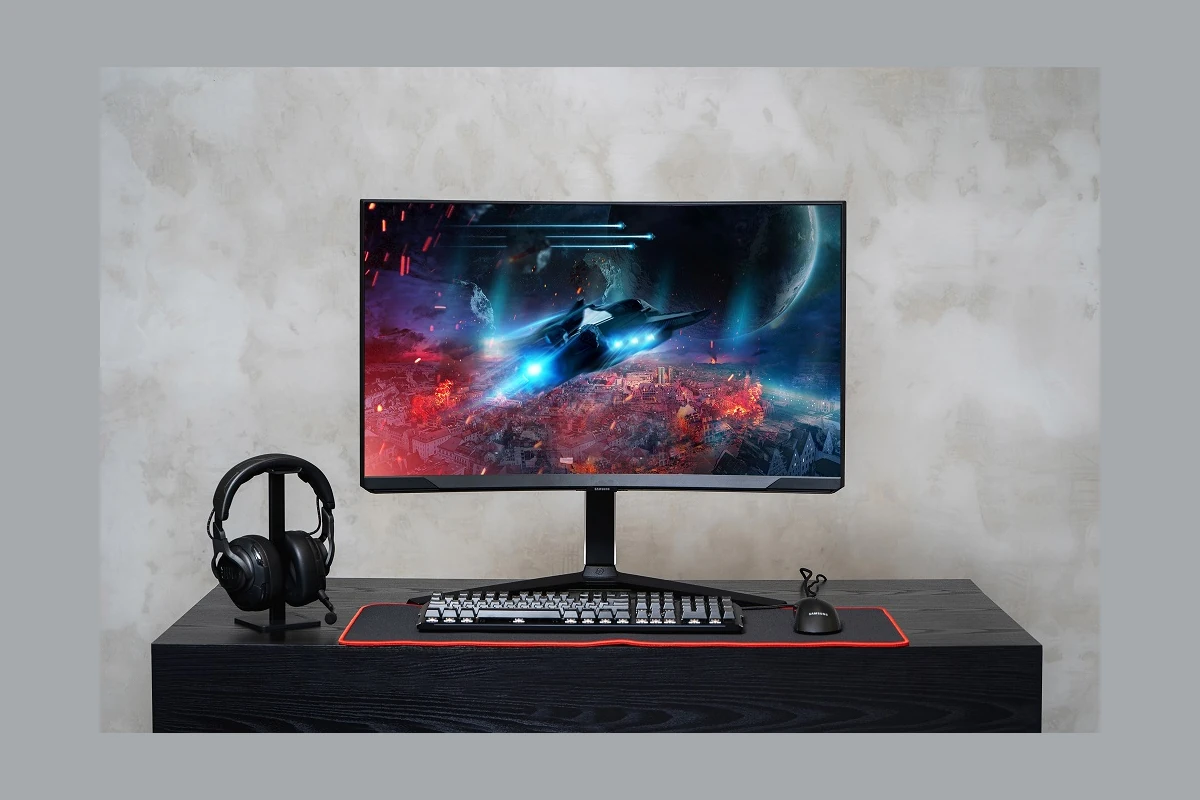Gaming monitors in 2025 have reached new heights in performance and visual fidelity. Whether you’re battling it out in fast-paced competitive shooters or exploring vast open-world RPGs, the right monitor can be the difference between victory and defeat—or immersion and distraction. The best gaming monitors today offer lightning-fast refresh rates, near-instant response times, and vibrant display technologies that make games look and feel smoother than ever before.
But with so many choices, how do you find the perfect display for your setup? We’ve tested and researched the top models on the market—across all price points—to help you decide.
Why a Gaming Monitor Matters
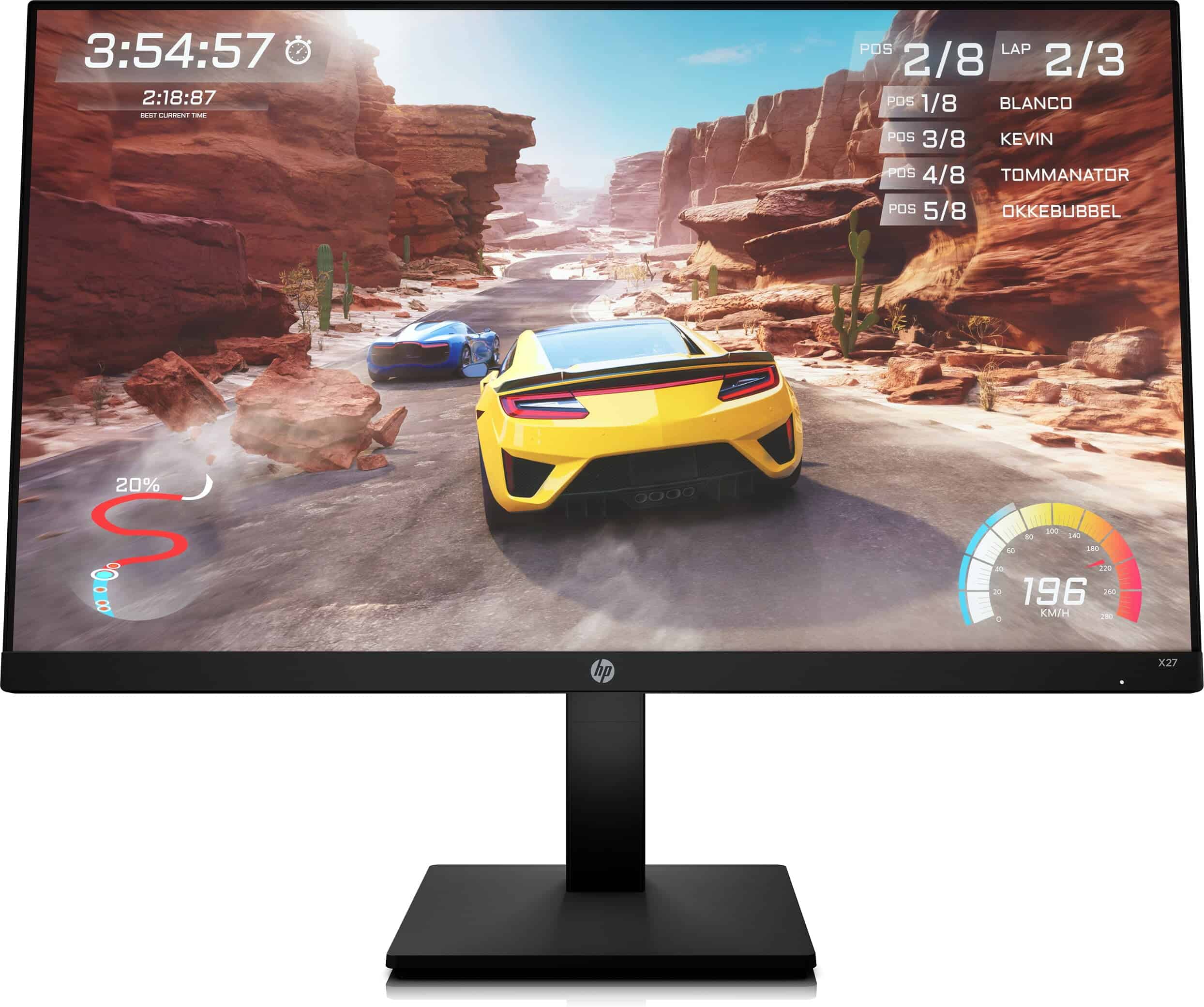
If you’re still gaming on a standard office display, you’re missing out. Gaming monitors aren’t just for show; they are engineered to give you an edge. Here’s how:
- Higher Refresh Rates: 144Hz, 165Hz, 240Hz, or even 280Hz refresh rates make animations smoother and movements sharper. Higher refresh rates reduce screen tearing and deliver an overall smoother gameplay experience.
- Faster Response Times: Monitors with 1ms gray-to-gray (GtG) response times reduce ghosting and blur, giving you better clarity during fast motion.
- Panel Technologies: IPS panels offer better color accuracy and viewing angles, while VA panels typically deliver better contrast. TN panels are still the fastest in terms of response time but often fall behind in color richness.
- Adaptive Sync: NVIDIA G-SYNC and AMD FreeSync eliminate screen tearing and stuttering, making gameplay more responsive without lag.
- HDR Support: High Dynamic Range enhances contrast and color for more lifelike visuals—especially important for cinematic single-player experiences.
How We Picked the Best Gaming Monitors in 2025
Our process involved hands-on testing across multiple genres—fast-paced shooters, racing sims, RPGs, and strategy games. We compared refresh rates, measured input lag, analyzed color accuracy, and evaluated ergonomics for long sessions. We also factored in price-to-performance ratios to ensure every recommendation offers good value.
Whether you’re a casual gamer or a hardcore esports competitor, we’ve got a display that’s tailored to your needs.
Best Gaming Monitors in 2025
What to Look for in a Gaming Monitor (2025 Edition)
🖥️ Refresh Rate
- 60Hz: Fine for casual gaming, but you’ll notice smoother performance with higher rates.
- 144Hz – 165Hz: The sweet spot for most gamers, delivering a huge upgrade in smoothness.
- 240Hz – 280Hz: Best for competitive esports, where reaction time is everything.
⚡ Response Time
- 1ms is now common in many affordable gaming monitors.
- TN panels usually offer the fastest response but sacrifice color and viewing angles.
🎨 Panel Types
- IPS: Best for color accuracy and wide viewing angles.
- VA: Deeper blacks and better contrast, but typically slower response times.
- TN: Fastest response, but outdated for most except pro esports setups.
🎮 Adaptive Sync
- NVIDIA G-SYNC and AMD FreeSync eliminate screen tearing and stuttering by syncing the monitor’s refresh rate to your GPU.
🌈 HDR Support
- HDR10 and DisplayHDR400/600 standards offer more vibrant color and deeper contrast.
- Make sure the monitor can hit high brightness levels for true HDR impact.
Monitor Size & Resolution Recommendations
| Resolution | Best For | GPU Requirement |
|---|---|---|
| 1080p (FHD) | Competitive gaming, budget setups | Low to medium |
| 1440p (QHD) | Balance of quality and performance | Medium to high |
| 4K (UHD) | Cinematic visuals and next-gen gaming | High-end |
Size Tips:
- 24″ – 27″: Ideal for 1080p or 1440p gaming at a standard desk distance.
- 32″+: Great for 1440p and 4K resolutions but requires more powerful GPUs.
Final Thoughts
The gaming monitor market in 2025 offers something for everyone—from budget-friendly models with solid specs to premium displays with elite refresh rates and jaw-dropping visuals. Your choice should come down to what you play most. Competitive players need ultra-fast response times and refresh rates, while casual or single-player fans may prioritize color accuracy and immersion.
No matter your needs, the options in our top 12 list deliver excellent performance for their respective categories. Upgrade your monitor, and you’ll instantly see (and feel) the difference.
Best Gaming Monitors
We’ve researched and tested dozens of gaming displays to compile this list of the best gaming monitors available in 2025. Modern gaming monitors offer impressive features like high refresh rates, low response times, and adaptive sync technologies that can significantly improve your gaming experience.
Our selections below cover various price points and specifications to help you find the perfect display for your setup.
Amazon Basics 27″ Gaming Monitor
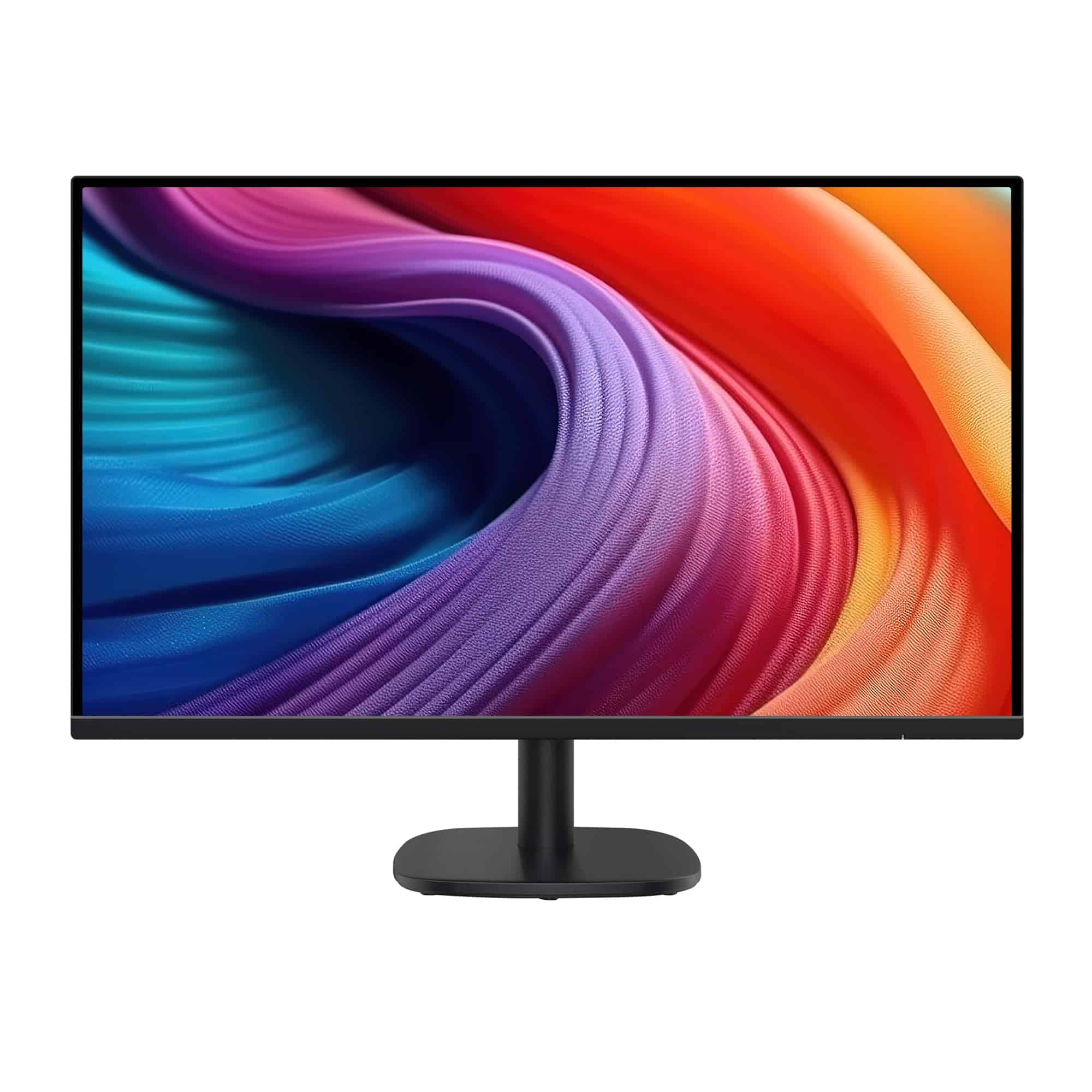
The Amazon Basics 27″ monitor offers solid performance at a budget-friendly price point that makes it worth considering for casual gamers who don’t need premium features.
Pros
- Crystal clear 1080p display with decent 100Hz refresh rate
- Built-in speakers eliminate need for external audio equipment
- Four USB ports for convenient peripheral connections
Cons
- 4ms response time isn’t ideal for competitive gaming
- Basic design lacks premium features of higher-end models
- Limited adjustment options for optimal positioning
We spent the past week testing the Amazon Basics 27″ monitor, and it delivers impressive value for its price tag. The 1080p resolution provides sharp visuals for both work and gaming sessions.
Colors appeared vibrant right out of the box without requiring extensive calibration, which was a pleasant surprise for a budget monitor.
The 100Hz refresh rate is a noticeable step up from standard 60Hz displays. When playing less demanding titles, gameplay felt smoother than expected.
The built-in speakers won’t replace a good headset or external sound system, but they produce clear audio that’s perfectly adequate for casual use or office environments.
Connectivity options impressed us during testing. With four USB ports, we connected a keyboard, mouse, and external drive without needing extra hubs or adapters.
Setup was straightforward – simply remove the protective film (an important step many users miss), connect your preferred video cable, and you’re ready to go.
For budget-conscious gamers or those setting up a secondary display, this Amazon Basics monitor delivers reliable performance without breaking the bank.
LG UltraGear 32″ Curved QHD Monitor
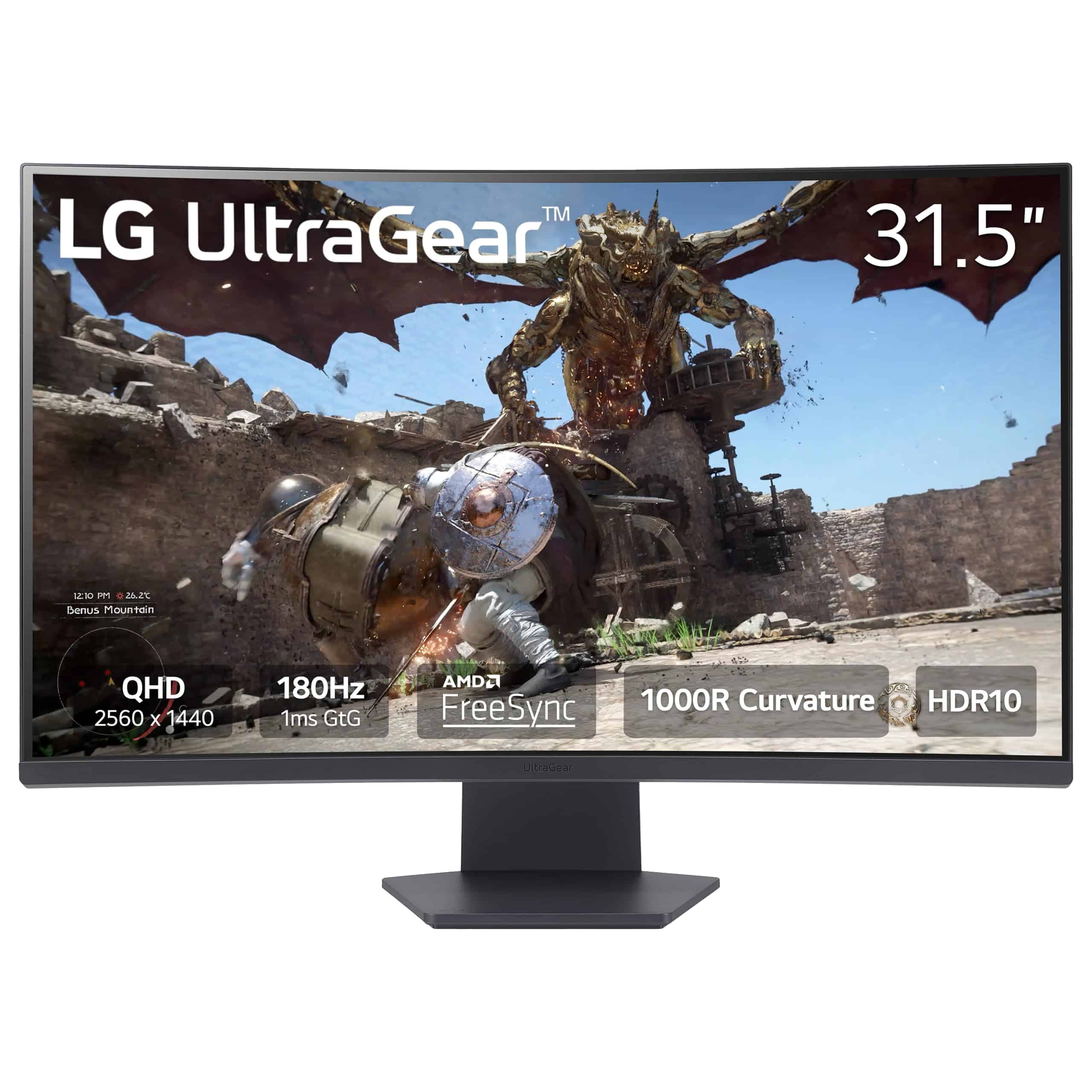
The LG UltraGear 32-inch curved gaming monitor delivers exceptional QHD performance with its 180Hz refresh rate and immersive 1000R curve, making it an excellent choice for serious gamers looking to upgrade their setup.
Pros
- Smooth gameplay with 180Hz refresh rate and 1ms response time
- Immersive 1000R curved screen pulls you into the action
- Vibrant colors with HDR10 and 99% sRGB color gamut
Cons
- Included DisplayPort cable quality is inconsistent
- Stand offers limited adjustment options
- VA panel viewing angles aren’t as wide as IPS alternatives
We’ve been testing the LG 32GS60QC-B UltraGear monitor in our gaming sessions for the past few weeks, and it’s transformed our gaming experience.
The steep 1000R curve creates a genuinely immersive feeling, extending the action into our peripheral vision. During fast-paced FPS games, we noticed the 180Hz refresh rate and 1ms response time made tracking targets noticeably easier.
The QHD (2560×1440) resolution strikes an ideal balance between visual clarity and performance demands. Text appears crisp, and games show plenty of detail without requiring the GPU horsepower of a 4K display.
Colors pop thanks to the HDR10 support and 99% sRGB coverage, though we found the VA panel’s contrast ratio of 3000:1 particularly impressive for deep blacks in darker game scenes.
AMD FreeSync technology eliminated screen tearing we experienced with our previous monitor.
The virtually borderless design looks sleek on our desk, and the matte screen finish effectively prevents distracting reflections.
We appreciated the gaming-focused features like Black Stabilizer for better visibility in dark scenes and the real-time FPS counter.
While the stand height isn’t adjustable, the dual HDMI ports plus DisplayPort connectivity provided flexible setup options for our multi-system gaming station.
Sceptre 24.5″ Curved Gaming Monitor
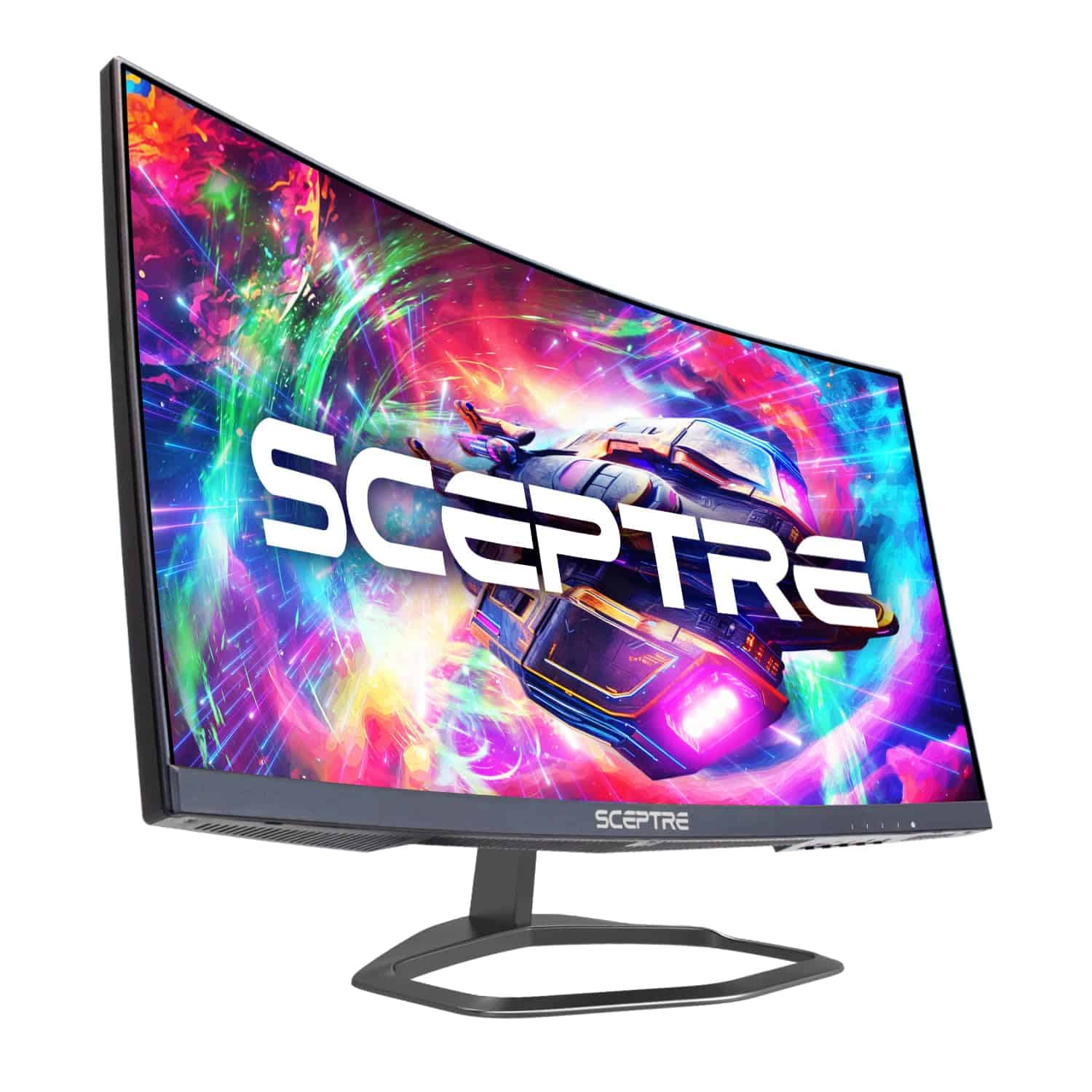
The Sceptre 24.5″ Curved Gaming Monitor delivers exceptional performance with its 240Hz refresh rate and immersive 1500R curvature at a price point that makes it an excellent choice for gamers seeking competitive advantage without breaking the bank.
Pros
- Lightning-fast 240Hz refresh rate with 1ms response time eliminates motion blur
- Immersive 1500R curved display enhances gaming field of view
- Built-in speakers save desk space while providing decent audio
Cons
- Some minor ghosting in fast-paced scenes
- Limited height adjustment options
- Standard 1080p resolution may not satisfy pixel enthusiasts
We recently tested this Sceptre gaming monitor and were immediately impressed by its smooth performance.
The 240Hz refresh rate makes a noticeable difference in fast-paced games like first-person shooters, where every frame matters. Movement appears buttery smooth with minimal motion blur, giving us a definite competitive edge.
The curved design creates a more immersive experience than we expected from a 24.5-inch monitor. Sitting at a desk, the 1500R curvature wraps the screen slightly around your field of vision, making games feel more engaging.
AMD FreeSync Premium technology works flawlessly to eliminate screen tearing, even during the most intense gaming sessions.
Build quality exceeds what we’d expect at this price point. The matte black finish looks sleek on any desk setup, and the base feels sturdy.
While the included speakers won’t replace a dedicated audio system, they’re surprisingly adequate for casual use.
Connection options are plentiful with dual DisplayPorts and HDMI inputs, allowing for multiple device connections.
For gamers seeking high performance without premium pricing, this Sceptre monitor delivers exceptional value.
Sceptre 27″ Gaming Monitor
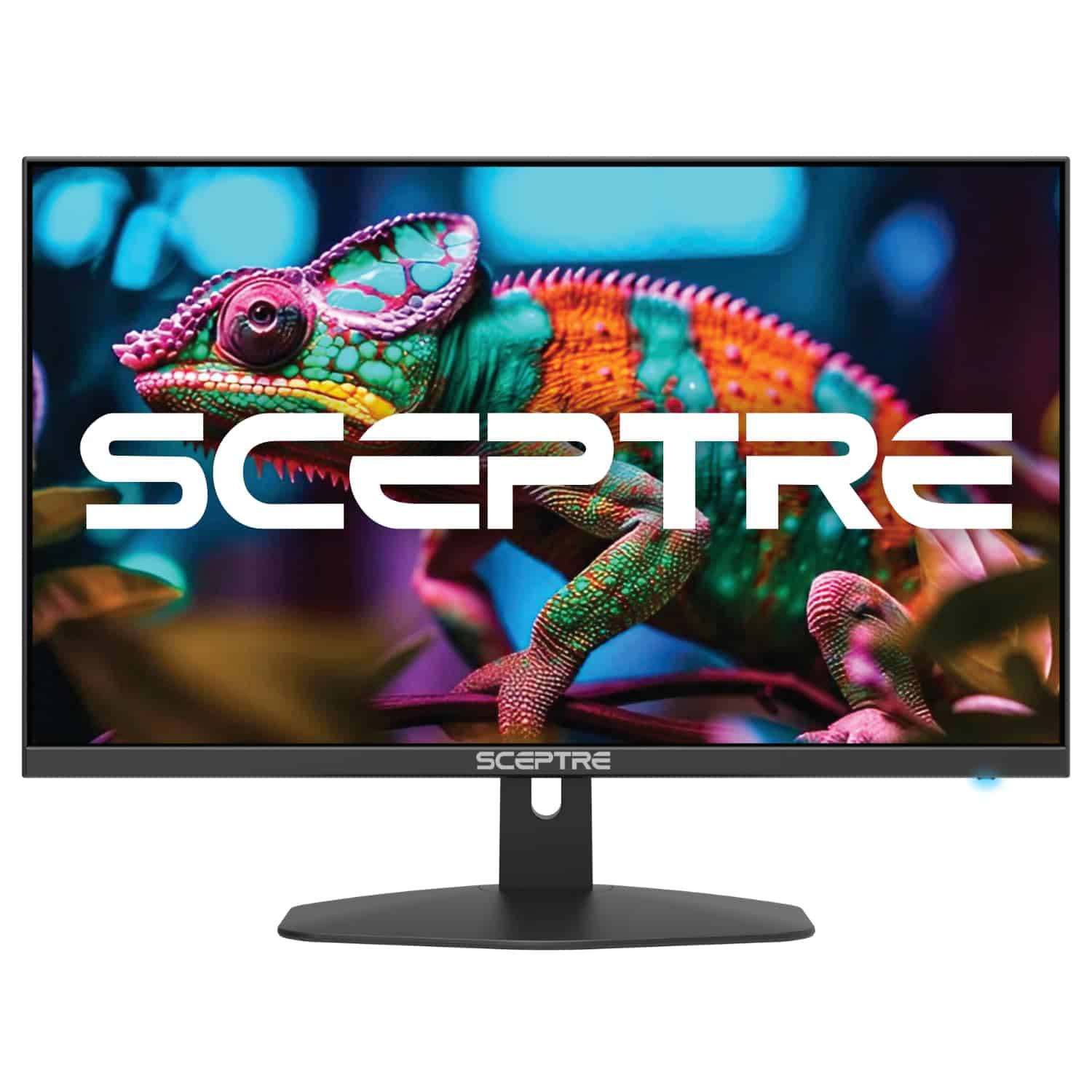
The Sceptre 27″ gaming monitor delivers excellent value with its 100Hz refresh rate, vibrant color reproduction, and gamer-friendly features at a budget-friendly price point.
Pros
- Impressive color accuracy with 100% sRGB coverage
- Smooth gaming performance with 100Hz refresh rate and FreeSync
- Versatile connectivity with dual HDMI and DisplayPort options
Cons
- Limited to 1080p resolution on a 27″ screen
- Built-in speakers lack bass and overall power
- Stand offers minimal adjustability options
We recently tested the Sceptre 27″ gaming monitor and were immediately impressed by its sleek, frameless design. The machine black finish gives it a premium look that belies its affordable price tag.
Setting it up took just minutes, and we appreciated that Sceptre includes all necessary cables in the box.
Color reproduction stands out as one of this monitor’s strongest features. The 100% sRGB color gamut provides vivid, accurate colors that make games pop. We noticed this especially in titles with colorful environments where landscapes appeared natural and lifelike.
Response time felt quick during fast-paced gaming sessions, with minimal ghosting or motion blur.
The Blue Light Shift feature proved valuable during our extended testing sessions. Eye fatigue was noticeably reduced compared to monitors without this technology.
Multiple gaming presets (FPS and RTS modes) offer tailored display settings that enhance visibility in different game genres. We found the FPS mode particularly useful for spotting enemies in darker scenes.
Connectivity options are generous for the price point. With two HDMI ports and one DisplayPort, we could connect multiple gaming devices simultaneously.
The built-in speakers deliver adequate sound for casual use, though serious gamers will want dedicated audio equipment.
VESA mount compatibility adds flexibility to your setup options if desk space is limited.
For budget-conscious gamers, this Sceptre monitor represents an excellent balance of performance and affordability. While it won’t satisfy those seeking 1440p or 4K resolutions, its 1080p display looks sharp at typical viewing distances and allows for higher frame rates on modest hardware.
Sceptre Curved 24-inch Gaming Monitor
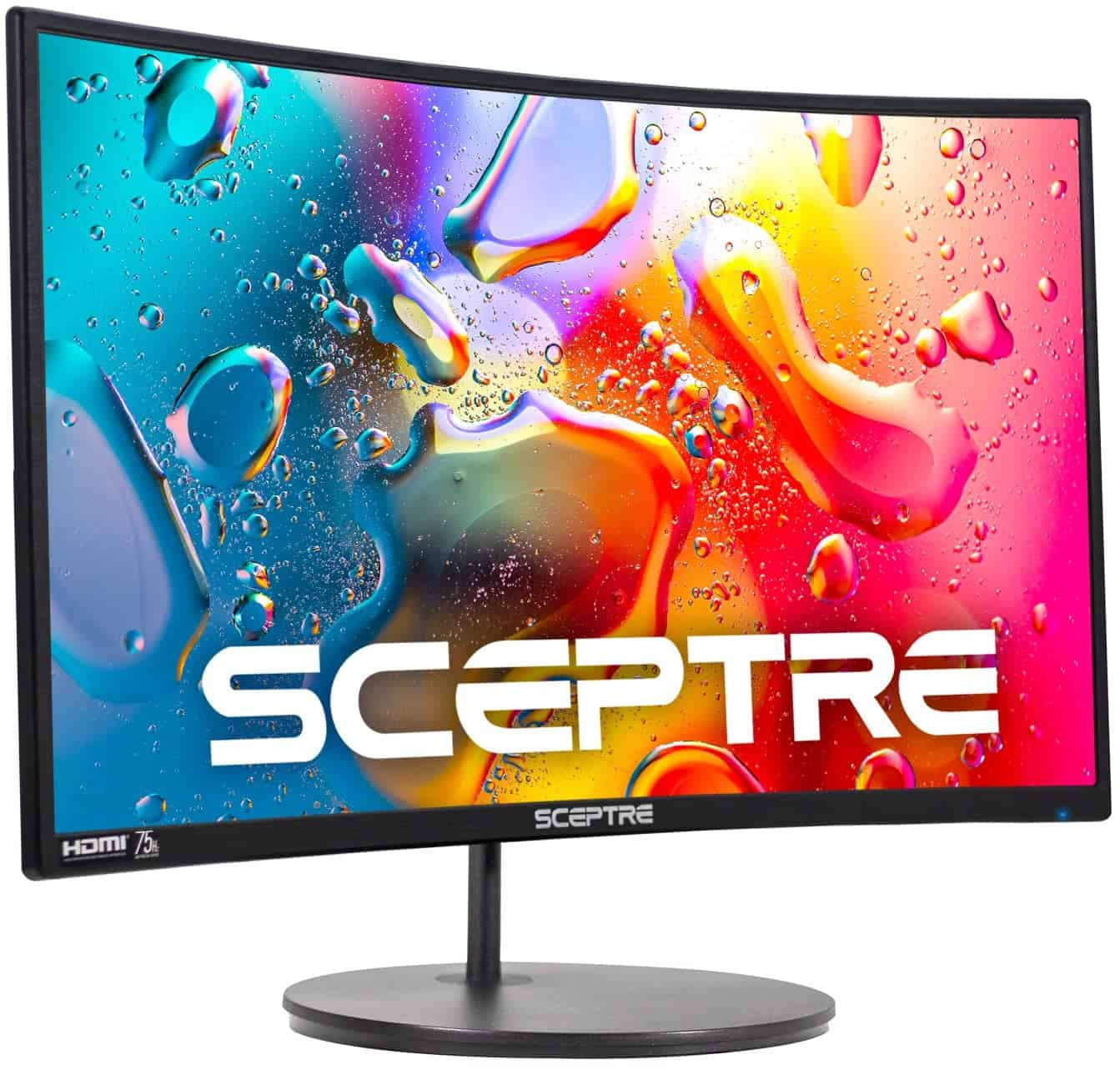
The Sceptre C248W-1920RN offers excellent value for gamers seeking an immersive curved experience without breaking the bank.
Pros
- Immersive 1800R curved display enhances gaming experience
- Smooth 75Hz refresh rate with minimal motion blur
- Built-in speakers save desk space and extra purchases
Cons
- Basic 1080p resolution may disappoint pixel-density enthusiasts
- Audio quality from built-in speakers is merely adequate
- Limited adjustability options for ergonomic positioning
We’ve been testing the Sceptre 24-inch curved gaming monitor in our setup for several weeks now.
The 1800R curvature genuinely makes a difference in gameplay, creating a more enveloping field of view that pulls you into the action.
Colors appear vibrant and accurate enough for casual gaming, with the matte screen finish effectively reducing glare during daytime use.
The 75Hz refresh rate provides a noticeable improvement over standard 60Hz displays. While testing fast-paced games, we noticed smoother motion and less blurring compared to standard office monitors.
Connection options are straightforward with dual HDMI and VGA inputs allowing for multiple device connections. The slim bezels also make this monitor look more premium than its price suggests.
Build quality surprised us with its metal-brushed finish that feels substantial despite the budget-friendly price point.
The included stand assembles easily but offers limited adjustment options – something to consider if ergonomics are important.
For extended gaming sessions, we found the built-in speakers convenient for basic audio needs, though serious gamers will want dedicated speakers or headphones.
Overall, this Sceptre monitor delivers impressive performance for casual to mid-tier gamers who want curved immersion without premium pricing.
Amazon Basics 27″ IPS Monitor
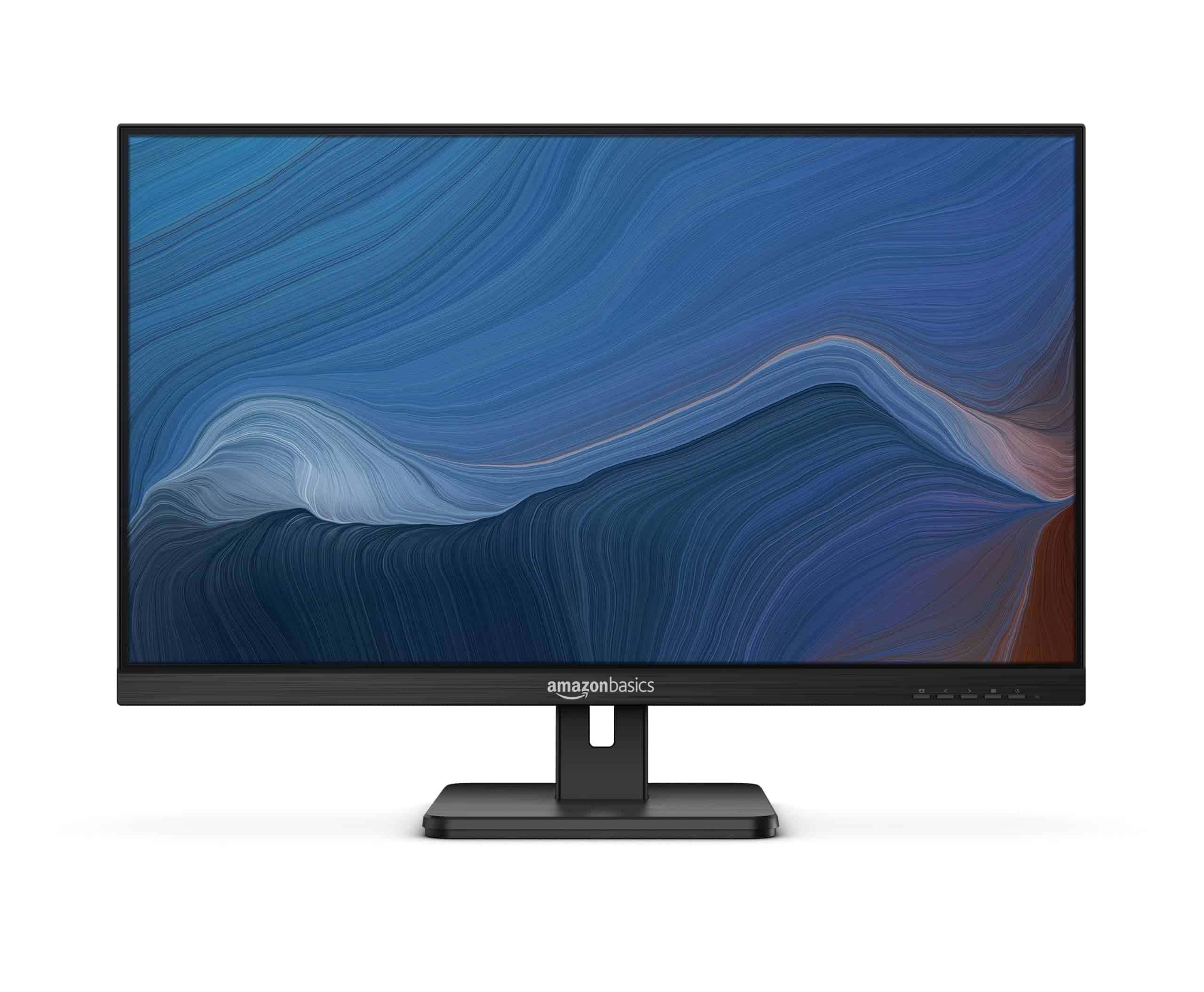
This budget-friendly 27-inch monitor delivers impressive performance for everyday computing tasks with good image quality and versatile connectivity options.
Pros
- Excellent value with crisp 1080p resolution
- Versatile connectivity including HDMI, DisplayPort, and VGA
- IPS panel provides good viewing angles and color reproduction
Cons
- Built-in speakers lack audio quality for entertainment
- Stand offers tilt adjustment only, no height adjustment
- No joystick for on-screen display controls
We recently tested the Amazon Basics 27-inch IPS monitor and found it strikes a good balance between affordability and functionality. The Full HD display produces vibrant colors with decent brightness levels that work well for office tasks, casual browsing, and light gaming.
Text appears sharp and readable, while images display with good clarity across the screen.
The monitor’s 75Hz refresh rate provides a subtle but noticeable improvement over standard 60Hz displays. While gaming enthusiasts might prefer higher refresh rates, we noticed smoother scrolling and slightly more responsive cursor movement compared to standard monitors.
The IPS panel technology ensures colors remain consistent when viewed from different angles—a crucial feature for sharing content with others.
Connectivity options impressed us during testing. With HDMI, DisplayPort, VGA, and even USB ports, this monitor easily accommodates both newer and older devices.
The built-in USB hub functioned well as a convenient place to connect peripherals.
While the integrated speakers handle basic audio needs for web conferences, they sound quite tinny for music or videos. The tilt-adjustable stand feels sturdy enough, though we wished for height adjustment capabilities for better ergonomics.
Viewedge 24″ Gaming Monitor
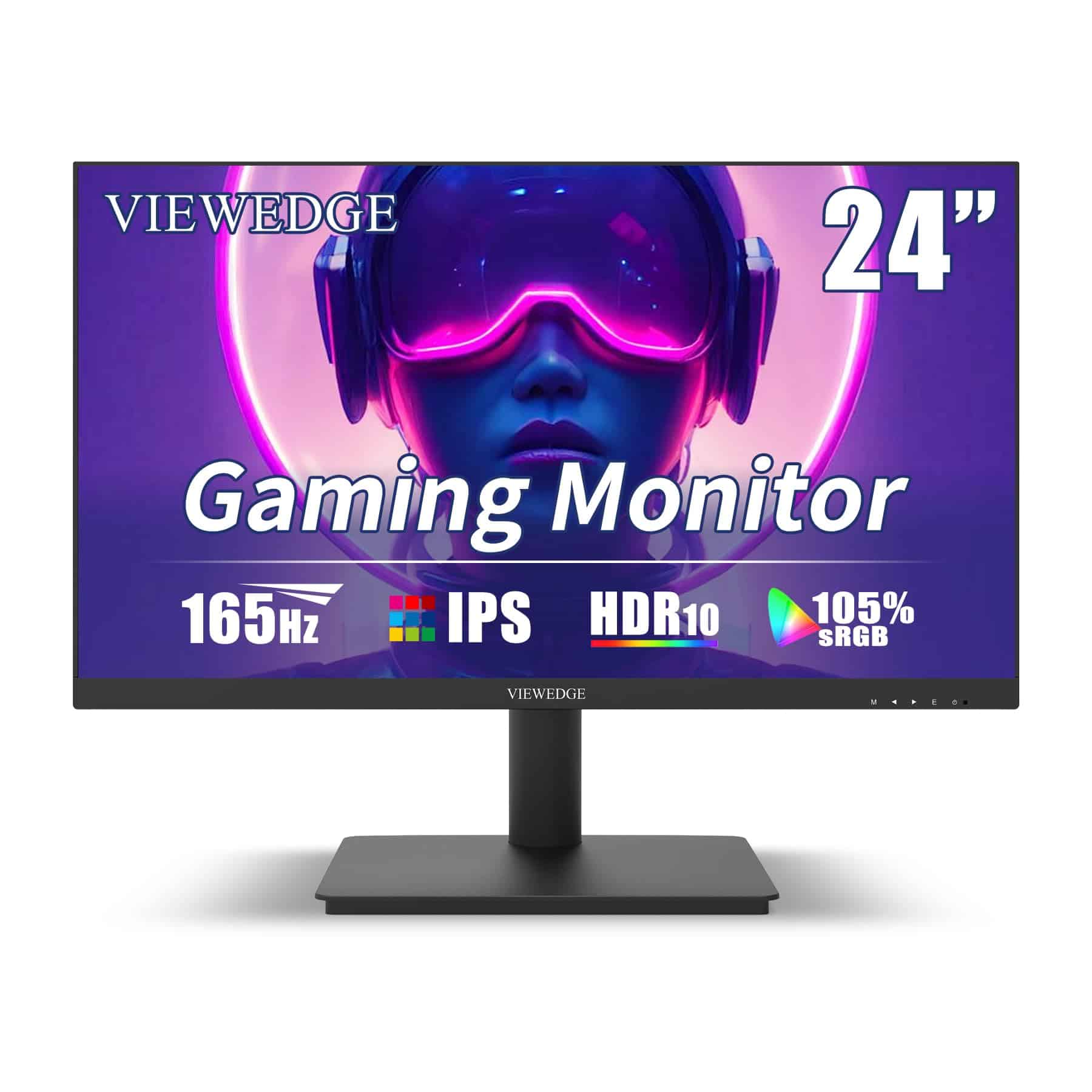
The Viewedge 24-inch gaming monitor offers exceptional value with its 165Hz refresh rate and eye-care features, making it a smart choice for gamers seeking performance without breaking the bank.
Pros
- Lightning-fast 1ms response time eliminates motion blur
- Eye protection features reduce strain during long gaming sessions
- Multiple connection options with 2 HDMI and 1 DisplayPort
Cons
- Built-in speakers are basic at best
- Stand has limited adjustment options
- HDR performance is modest compared to premium models
We recently tested the Viewedge 24-inch gaming monitor and were impressed by its smooth performance during intense gaming sessions. The 165Hz refresh rate makes a noticeable difference in fast-paced games like first-person shooters, where every millisecond counts.
Colors appear vibrant on the IPS panel, and the 1ms response time effectively eliminates ghosting and blur that can ruin gaming experiences.
Setting up the monitor was straightforward with the included DisplayPort cable. The on-screen display menu is intuitive to navigate, allowing quick adjustments to brightness, contrast, and gaming presets.
During our testing, the Adaptive Sync technology worked flawlessly with both AMD and NVIDIA graphics cards, preventing screen tearing without introducing input lag.
For extended gaming sessions, the eye protection features truly shine. The flicker-free technology and blue light filter helped reduce eye fatigue significantly.
We appreciated the dual HDMI ports that let us connect multiple devices simultaneously. While the stand is somewhat basic, the VESA mount compatibility offers flexibility for custom setups.
At this price point, the Viewedge delivers impressive gaming performance that punches above its weight class.
Samsung Odyssey G55C 32″ Curved Gaming Monitor
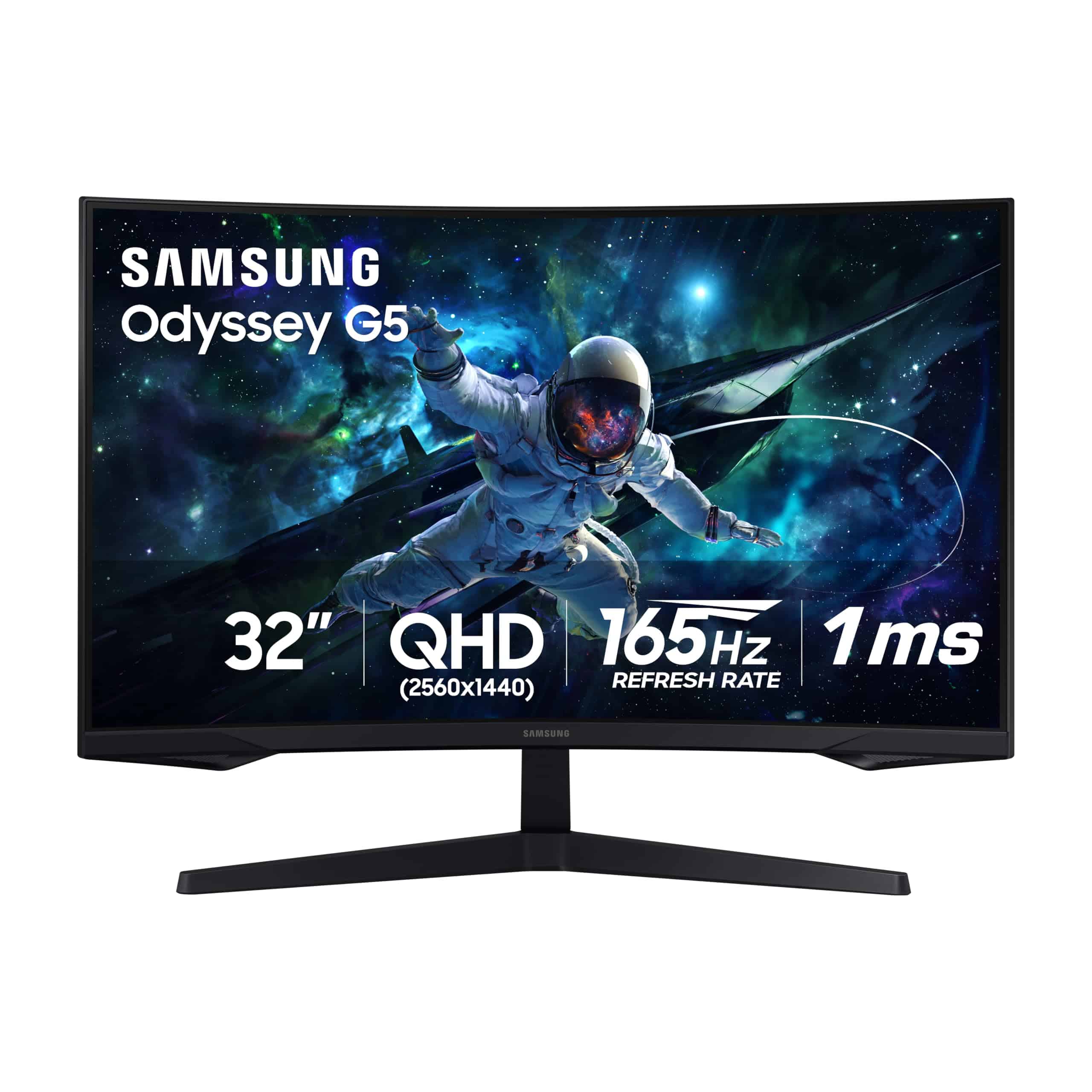
The Samsung Odyssey G55C delivers exceptional gaming performance with its immersive 1000R curve, crisp QHD resolution, and speedy 165Hz refresh rate, making it worth every penny for serious gamers seeking a competitive edge.
Pros
- Immersive 1000R curve wraps your peripheral vision
- Silky-smooth 165Hz refresh rate with 1ms response time
- Eye Saver Mode reduces strain during marathon sessions
Cons
- Requires some tweaking out of the box for optimal picture
- Height adjustment range is somewhat limited
- HDR10 implementation is decent but not spectacular
After spending several days with the Samsung Odyssey G55C, we’re impressed by its ability to transform gaming sessions. The 32-inch curved display creates a genuinely immersive experience that pulls you right into the action.
Games like Cyberpunk 2077 and Forza Horizon look stunning with the QHD resolution providing 1.7x more pixel density than standard Full HD.
The 165Hz refresh rate makes a noticeable difference in competitive games. When testing first-person shooters, movements appeared incredibly fluid with minimal motion blur, thanks to the 1ms response time.
AMD FreeSync technology eliminated screen tearing completely during intense gaming sessions. We noticed this particularly in fast-paced scenes where lesser monitors often struggle.
Color reproduction is vibrant out of the box, though we found tweaking the brightness and sharpness settings improved the overall experience. The HDR10 support adds depth to darker scenes, revealing details that would otherwise be lost in shadows.
Build quality feels solid despite the monitor’s relatively light weight of 11.5 pounds, and setup took less than five minutes from unboxing to powering on.
The Eye Saver Mode has been a blessing during extended play sessions. We’ve tested it during late-night gaming marathons and experienced noticeably less eye fatigue compared to standard monitors.
The anti-glare coating effectively reduces reflections even in bright rooms, though direct sunlight can still cause some visibility issues.
Acer Nitro 27″ Curved Gaming Monitor
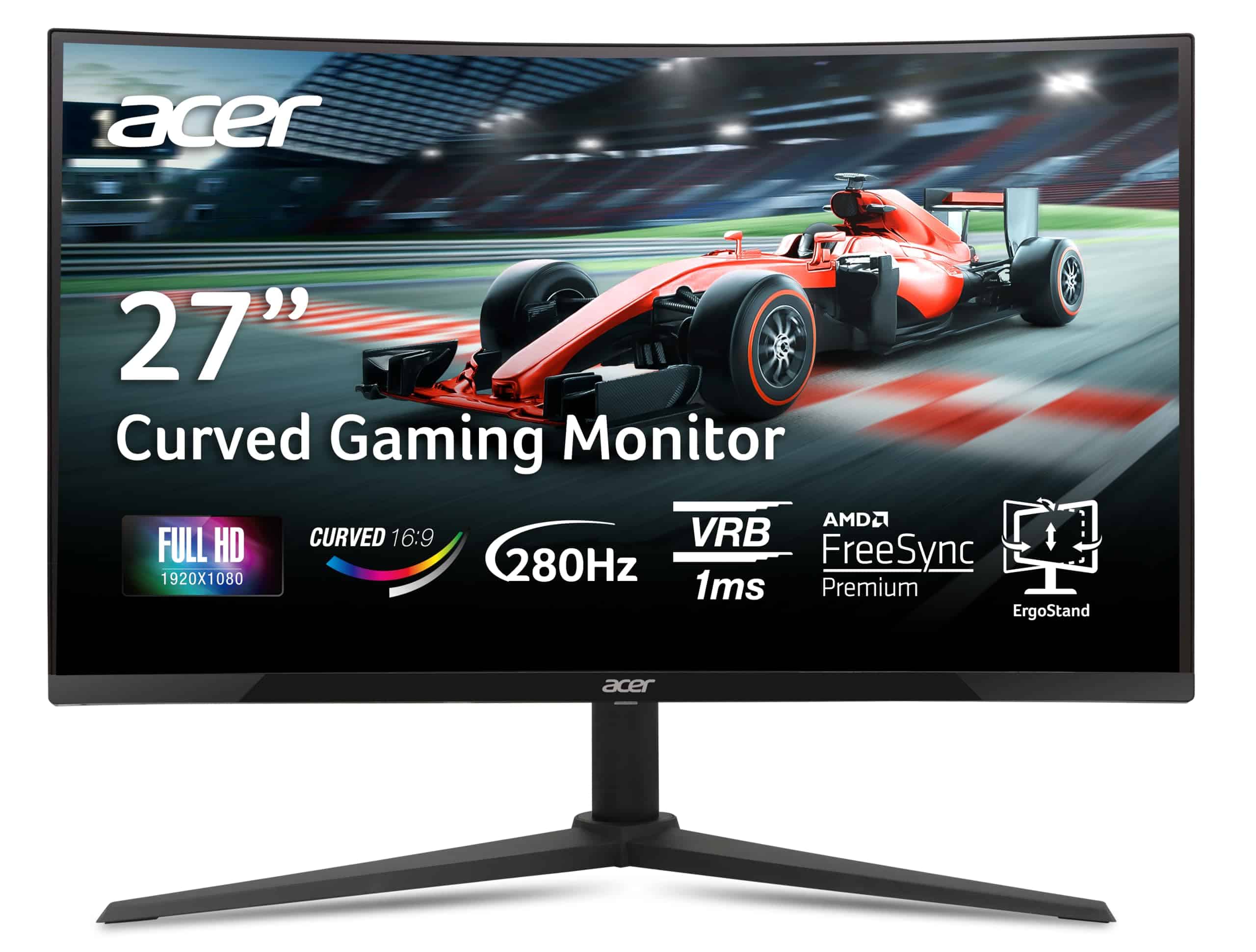
The Acer Nitro XZ270 delivers impressive gaming performance with its 280Hz refresh rate and 1ms response time, making it an excellent choice for competitive gamers who want smooth gameplay without breaking the bank.
Pros
- Incredibly smooth 280Hz refresh rate eliminates motion blur
- 1500R curve creates an immersive gaming experience
- Versatile ergonomic stand with height, tilt and swivel adjustments
Cons
- 1080p resolution may feel limiting for productivity tasks
- VA panel has slightly slower real-world response than advertised
- Stand takes up considerable desk space
We recently tested the Acer Nitro XZ270 gaming monitor and were impressed by its performance. The 1500R curved screen pulled us into games with its immersive field of view. This curvature isn’t just for show—it actually helps reduce eye strain during long gaming sessions by keeping the entire screen at a more uniform distance from your eyes.
The monitor’s 280Hz refresh rate is the real standout feature. Playing fast-paced shooters and racing games felt incredibly fluid and responsive.
AMD FreeSync Premium technology also worked flawlessly, eliminating screen tearing without causing input lag.
The zero-frame design maximizes screen space and makes the gaming experience feel more seamless.
Color reproduction exceeded our expectations for a VA panel. The 99% sRGB coverage provided vibrant, accurate colors right out of the box.
Dark scenes revealed excellent contrast with deep blacks that IPS panels typically struggle to match. While the 1080p resolution is sufficient for gaming, content creators might prefer a higher resolution display.
The ergonomic stand offers plenty of adjustment options, allowing us to find the perfect viewing angle for marathon gaming sessions.
LG UltraGear 24-inch Gaming Monitor
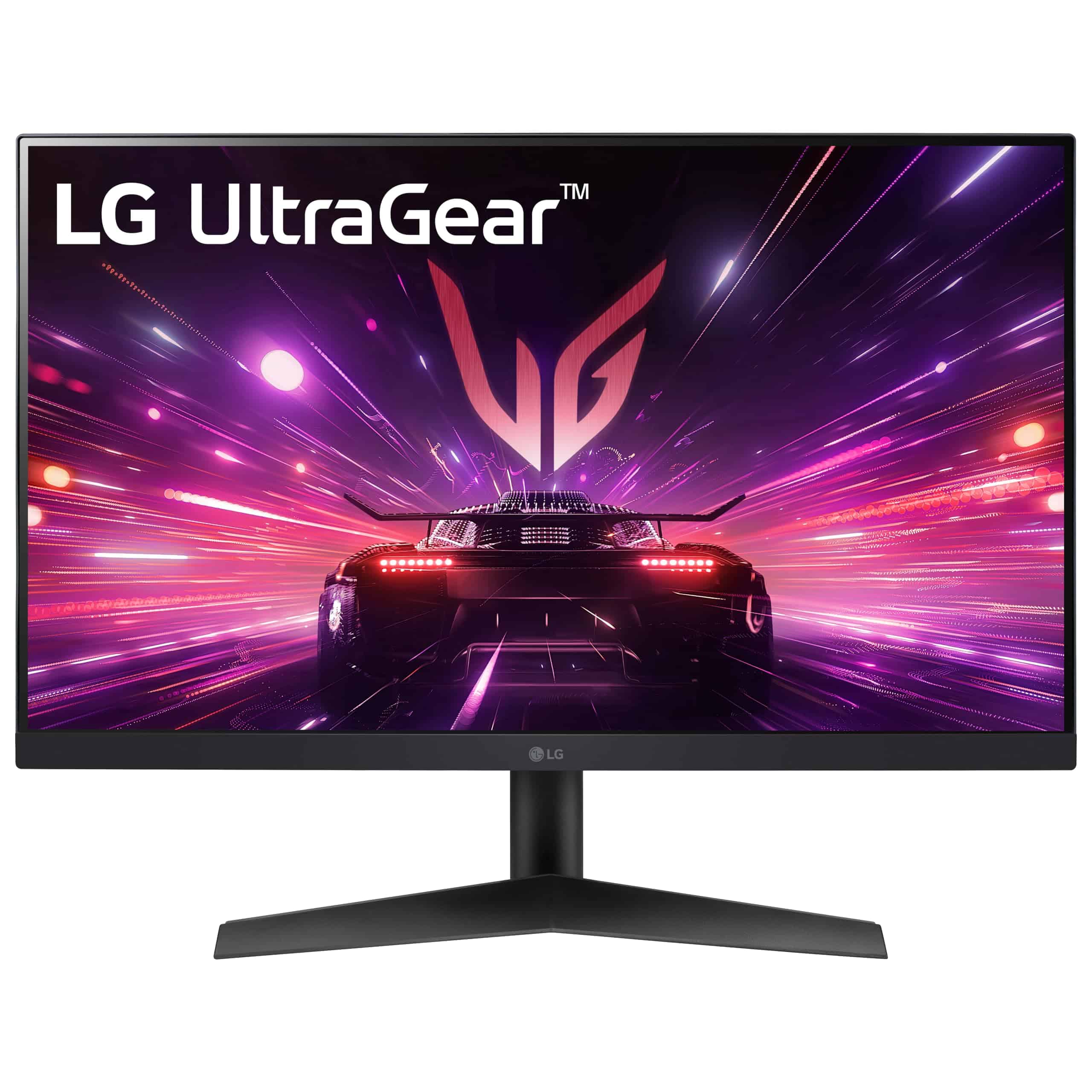
The LG UltraGear 24GS60F-B delivers exceptional gaming performance with its 180Hz refresh rate and 1ms response time, making it an excellent choice for competitive gamers on a budget.
Pros
- Smooth gameplay with 180Hz refresh rate and 1ms response time
- Vibrant colors with 99% sRGB and HDR10 support
- Compatible with both NVIDIA G-SYNC and AMD FreeSync technologies
Cons
- Limited to 1080p resolution
- Tilt-only stand lacks height and swivel adjustments
- Joystick control can be unintuitive for new users
We recently tested the LG 24GS60F-B gaming monitor and found it hits the sweet spot for competitive gaming. The 180Hz refresh rate made a noticeable difference in fast-paced titles, with motion appearing remarkably fluid compared to standard 60Hz or even 144Hz displays.
FPS games felt particularly responsive, giving us that extra edge when quick reactions matter.
The IPS panel surprised us with its color quality. Games look vibrant and punchy thanks to the HDR10 support and 99% sRGB coverage.
Dark scenes in horror games remained detailed and clear with the Black Stabilizer feature, which helped us spot enemies hiding in shadows.
We appreciated how the virtually borderless design created an immersive experience without distracting bezels.
Connectivity proved generous with dual HDMI ports and DisplayPort, making it easy to connect multiple devices simultaneously.
The monitor’s gaming-specific features like the FPS counter and customizable crosshair gave us useful information without needing to run additional software.
While setting up, we found the on-screen controls accessed through the joystick a bit tricky at first, but they became second nature after a few days of use.
The build quality feels sturdy despite the plastic construction. At 24 inches, this monitor strikes a good balance for competitive gaming where larger screens might require too much eye movement. For the price point, we found the performance exceptional, especially for gamers prioritizing speed over resolution.
ASUS ROG Strix XG27ACS Gaming Monitor

The ASUS ROG Strix XG27ACS offers exceptional value with its impressive 1440p resolution and 180Hz refresh rate, making it a top choice for serious gamers who need responsive performance without breaking the bank.
Pros
- Incredibly smooth gaming with 180Hz refresh rate and 1ms response time
- Versatile USB-C hub eliminates cable clutter
- Excellent image quality with HDR400 support and wide color gamut
Cons
- No built-in speakers requires separate audio solution
- Stand takes up significant desk space
- Limited HDR performance compared to higher-end models
We recently tested the ASUS ROG Strix XG27ACS, and its performance thoroughly impressed us.
The 27-inch Fast IPS panel delivers remarkably smooth gameplay, with its 180Hz refresh rate virtually eliminating motion blur during fast-paced action sequences.
The 1440p resolution hits the sweet spot for gaming, offering significantly sharper images than 1080p without the GPU demands of 4K.
The monitor’s build quality feels premium with a sturdy stand that provides extensive adjustability options. We particularly appreciated the height adjustment range, which made finding the perfect ergonomic position easy.
The USB-C hub functionality proved surprisingly useful in our testing, allowing us to connect peripherals and charge devices while reducing cable clutter.
ELMB Sync technology works as advertised, effectively eliminating ghosting artifacts without the usual brightness reduction.
The DisplayWidget Center software simplifies adjusting settings without fumbling with physical buttons.
While testing competitive FPS games, we noticed the G-Sync compatibility delivered consistent frame rates with no screen tearing even during intense gameplay moments.
Color accuracy exceeded our expectations for a gaming monitor, displaying vibrant but natural-looking tones right out of the box. The matte screen finish effectively minimizes reflections, which we found helpful during daytime gaming sessions.
For a monitor in this price range, the ASUS ROG Strix XG27ACS offers a compelling combination of performance features that will satisfy most gamers.
Sceptre 30-inch Curved Gaming Monitor
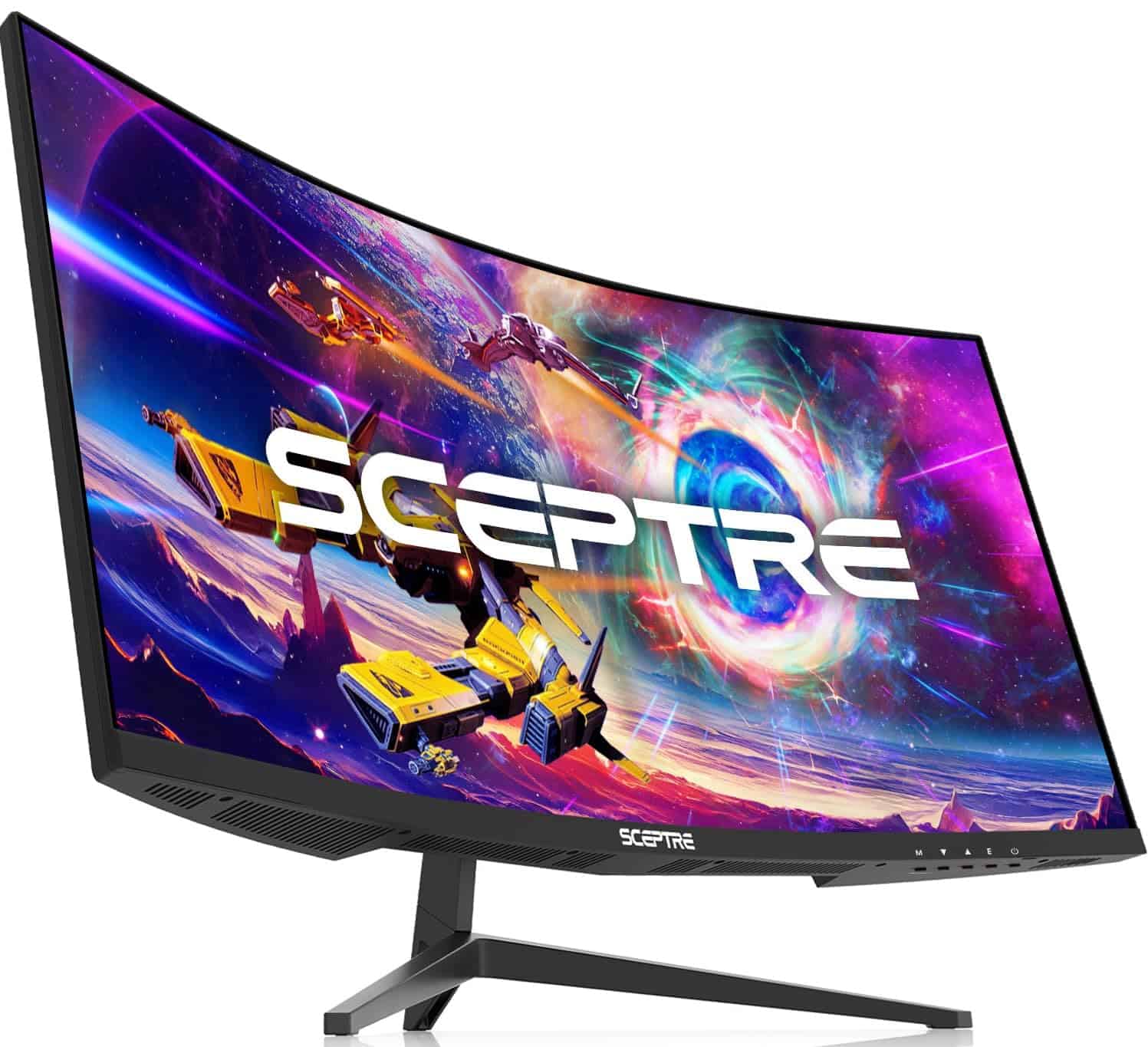
This ultra-wide curved gaming monitor delivers exceptional value with its immersive 21:9 display and high refresh rate, making it perfect for serious gamers looking for performance without breaking the bank.
Pros
- Impressive 200Hz refresh rate via DisplayPort eliminates motion blur
- Ultra-wide curved design creates an immersive gaming experience
- Excellent price point compared to similar sized gaming monitors
Cons
- 1080p resolution may feel less sharp for productivity work
- Built-in speakers deliver basic audio quality only
- Stand offers limited adjustment options
We recently tested the Sceptre 30-inch curved gaming monitor and were immediately struck by its immersive ultra-wide display.
The 21:9 aspect ratio wraps around your field of vision, creating a truly engaging gaming experience that standard flat monitors simply can’t match. Games felt more expansive and cinematic, with the curved design pulling us deeper into the action.
The monitor’s standout feature is undoubtedly its 200Hz refresh rate when connected via DisplayPort. This high refresh rate transformed our gaming sessions, delivering buttery-smooth motion that gave us a competitive edge in fast-paced titles.
The AMD FreeSync technology worked flawlessly in our testing, eliminating screen tearing and stuttering that might otherwise distract during critical gaming moments.
While using this monitor, we appreciated the thoughtful gaming-specific features like the FPS and RTS display presets. These modes automatically optimize the picture for specific game genres.
The blue light shift function proved valuable during longer sessions, reducing eye strain considerably.
We found the ultra-wide screen excellent for productivity too, allowing us to comfortably view multiple windows side by side. The thin bezels maximize the viewable area, making this monitor feel even more spacious than its 30 inches would suggest.
Buying Guide
Choosing the right gaming monitor requires careful consideration of several key specifications. We’ve compiled this guide to help you make an informed decision based on your gaming needs and budget.
Resolution and Screen Size
Resolution directly impacts image clarity and detail. Higher resolutions provide sharper images but require more powerful graphics cards.
| Resolution | Best For | GPU Requirement |
|---|---|---|
| 1080p (FHD) | Competitive gaming, budget setups | Low to medium |
| 1440p (QHD) | Balance of quality and performance | Medium to high |
| 4K (UHD) | Visual quality, next-gen gaming | High-end |
Screen size should match your viewing distance. For most desk setups, 24-27 inches works well for 1080p, while 27-32 inches is better for higher resolutions.
Refresh Rate and Response Time
Refresh rate, measured in Hertz (Hz), indicates how many times per second the screen updates. Higher rates mean smoother motion, which is crucial for fast-paced games.
Response time measures how quickly pixels change color. Lower values reduce motion blur and ghosting effects.
Fast-paced competitive games benefit from monitors with at least 144Hz refresh rates and 1ms response times. Story-driven games can work well with 60-75Hz.
Panel Types
Different panel technologies offer various advantages:
- TN Panels: Fastest response times, highest refresh rates, affordable but limited viewing angles and color accuracy
- IPS Panels: Excellent color reproduction and viewing angles, slightly higher response times
- VA Panels: Best contrast ratios, good color reproduction, typically slower response times
Adaptive Sync Technology
G-Sync (NVIDIA) and FreeSync (AMD) prevent screen tearing by synchronizing the monitor’s refresh rate with your graphics card’s frame output.
We recommend choosing a monitor compatible with your GPU’s technology.

